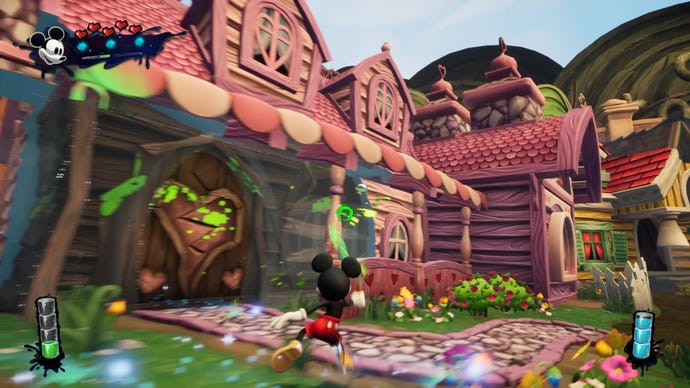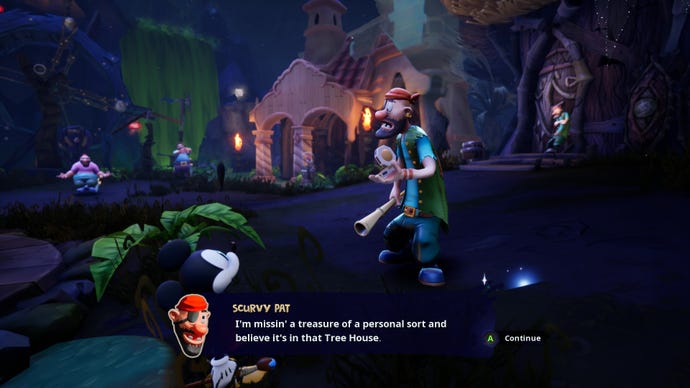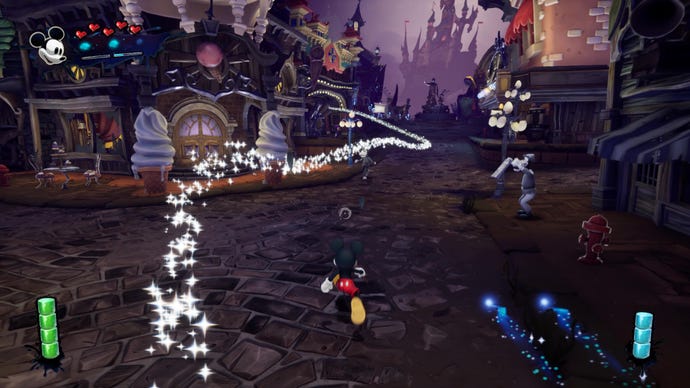Disney Epic Mickey: Rebrushed is a remaster of Disney Epic Mickey, a cult classic 3D platformer first released a decade ago on the Wii. In the original you controlled the titular Mickey Mouse who, armed with a magical paintbrush (wieldable by waving the Wiimote about), could paint or rub out surfaces to solve puzzles. It was the work of Junction Studios led by Warren Spector, best known for being The Deus Ex Guy. No, sadly Mickey could not nano-augment his brush for better target acquisition, nor project laser-guided anti-tank rockets from his podgy white mitts.
And no, Rebrushed doesn’t let him do anything of these either. Clearly a missed opportunity. But is it better nonetheless? With an updated look, some added secrets, more moves for Mickey, and controller/M&K support, I’d say longtime Mickey heads will adore this nostalgia trip. For total newcomers like me, I’d say it’s a platformer that’s certainly charming and clever and wonderfully experimental, but a bit flat in places too.
The story of Rebrushed begins with a monumental cockup. Mickey is awoken by a magical mirror that transports him into the house of a wizard, who seems to be painting a lovely world onto canvas. The wizard leaves satisfied with his work, so Mickey’s like, “I best fucking slop some paint about lol”, and proceeds to do just that. Only he knocks an entire bottle of thinner onto the canvas while he’s at it, because he’s an idiot. The wizard’s world now in shambles and radiating some evil energy, Mickey pisses off back into the mirror and to the safety of his room. Remarkably, he then falls right back asleep like nothing’s happened. Only then does karma get his ass, as he’s dragged back through the mirror by an evil hand and into the ruined painting.

And so, Mickey is armed with the magical brush he wrongfully picked up in the first place, and tasked with righting the world he’s ravaged from the inside. I find Disney a bit of a shoulder shrug, in all honesty (I chose Dexter’s Laboratory and Hell In A Cell matches over The Lion King growing up), but I will admit that the game’s setting is neat. In that it’s a world inhabited by Disney’s forgotten creations and misfits, which is both an interesting insight into a back catalogue and a motivation: you do really want to save these poor folks.
That’s best achieved, it turns out, through some platforming, aided by “ho ho” double jumps and an ability to paint or thin surfaces. It’s the latter that’s the crux here, as Rebrushed isn’t designed as a movement-first platformer. In fact, Mickey’s a bit shite at rodentkour, what with his weirdly floaty falls and tendency to just slide off edges rather than grab at them. Throughout his adventures, he retains the same mediocre moveset, too, so don’t expect him to develop some Celeste-esque air dashes or Mario hop-skips-and-vaults.
Instead, Rebrushed focuses on the waggling of the brush. Guided easily and accurately by your mouse or your controller thumbsticks, you can hit highlighted zones with either paint or thinner: select the blue splodge of paint and you’ll fill things in, while the green splodges of thinner burn bits away. Again, you don’t develop new brush-wagging skills or meet, say, Daffio Vequackquez who lends you some new oil paints. Ultimately, challenge and enjoyment lay heavily on how each level is laid out.



Through Mickey’s travels, you’ll pass through sewery slums, wrecked theme parks with rickety rockets, crumbling ruins, fire-stricken towns, and pirate-infested isles. You move through these spaces at quite a pace, too, as each spot is broken up into easily digestible mechanical conundrums. Almost all of which have you tick things off a checklist: get the masks, find the switches, rescue the pals. A lot of what you’ll do is run around a space and search for the highlighted bits, filling or thinning as is often quite obvious. You might need to flip a switch up on the thingamajig, so you paint some platforms to get there. A chest might be alight, so you thin the platform above it where water barrels rest. The best bits have you paint or thin cogs, so they help spin or hold platforms in place for you.
It’s all pretty simple stuff and it’s hard to get truly stuck, even for me. But I find its relative ease quite relaxing, and a testament to each level’s layout. I like how you’re often given what sounds like a tedious or intimidating “find the Xs and Ys” mission, but then find surfaces and pathways that are highlighted or folded into each other in such a way as to complement a natural curiosity. Or, indeed, the explorative tendencies of someone like myself, who plods around and chalks this up to being a “vibes based” problem solver. This grants each place a real playground feel as you go about splashing paint or thinner, discovering plenty of optional secrets by accident.
These 3D platforming main events are connected by other 2D mini-levels, sort of like portals into forgotten or lost Disney episodes. You might have to hop through Willy Doo: The Goose’s (I have made this character up) steamboat as he contends with whales (I have also made this bit up), in what’s often classic 1930’s styling of trumpet parps and bobbing characters with big eyes. They’re somewhat fun, if a very straightforward test of double jumps, as there’s no painting or thinning powers in these ancient realms. Really, they exist to please Disney fans and lightly educate laypeople, as they very much feel like they could’ve been levels designed for a pop-up stand in Walt’s museum.

After you’ve burst out of these levels, you might end up in a couple of hub spaces you’ll return to a handful of times over the course of the story. The main one being Mean Street, home to vendors with menial sidequests that’ll grant you either: 1) a collectible pin or 2) an orb. Those pins feature a lot, often as rewards for finding secret spots as you thin or paint stuff out in the world, which is infuriating for me as a person who doesn’t care for them, but may satisfy those of you who love this sort of thing. Anyway, yeah, there’s also a Gremlin in Mean Street who asks you to grab him however many orbs to power more portals to 3D levels, and thus, more mandated Mickeying.
Said mandated Mickeying does feature some interesting decision-making, though, which remains more “interesting” than it does actually impactful – but still. At the most basic level, combat revolves around painting enemies or thinning them. Paint them enough and they’ll turn friendly, while thinner just outright erases them (some enemies can only be thinned, then spin attacked). Some levels have Gremlins trapped in cages, too, where they might offer to fix or fudge bits around the map to either make your route to the main objective a bit easier, or open up a room to yet another pissing pin. Another time, I gave a pirate some ice cream to woo a lady he was into, without consulting what the lady may have wanted. Apparently she wasn’t into ice cream.

Much of the choices feel a bit embryonic, or a bit experimental, like they’re not fully fleshed out just yet: the ice creams and the gremlins and whatnot don’t really have a lasting impact. Some bosses, though, can either be defeated by painting or thinning them, in clever tussles where you’ve truly got to balance your paint, thinner, and hops to avoid falls or arm slams. Whatever substance you choose determines their fate, either as an eroded husk or a character saved from corruption. Save a lad called Petetronic and his regular counterpart Pete, a vendor in Mean Street, might be like “Well done” and give you a spark. So don’t expect immediate, earth-shattering consequences. Instead, it’s one of those games where those decisions are tallied by Dick Disney in the background and a Good or Bad ending selected for you once the credits roll.
As someone who doesn’t really get on with the source material, I find myself warmed by Disney Epic Mickey: Rebrushed. It’s not all that challenging and sometimes a bit eh, but I liked that easygoing nature more than I resented it. You’re free to splosh paint around and stumble into cool mechanical puzzles or simply remove the floor from an enemy and watch them plunge to their death. And while some of the side quests and optional tidbits don’t amount to much more than, at most, an end credit sequence, I admire its adventurous spirit. You can tell it tries to do things a bit differently to the usual platformer and for the most part, it works!
This review is based on a review build of the game provided by the publisher.













